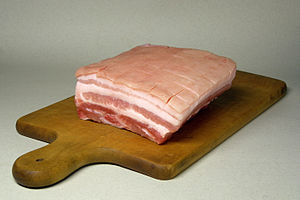Cookbook:Pork
| Pork | |
|---|---|
 | |
| Category | Meat and poultry |
Cookbook | Recipes | Ingredients | Equipment | Techniques | Cookbook Disambiguation Pages | Ingredients | Basic foodstuffs
Pork is the meat from hogs, or domestic swine. The domestication of "pigs" (immature hogs) for food dates back to about 7000 B.C. in the Middle East. However, evidence shows that Stone Age man ate wild boar, the hog's ancestor, and the earliest surviving pork recipe is Chinese, at least 2000-years old. While it is one of the most common meats eaten by the Chinese and Europeans, it is considered inedible under Islamic and Orthodox Jewish law.
Retail Cuts of Fresh Pork
[edit | edit source]
There are four basic (primal) cuts into which pork is separated: shoulder, loin, side and leg.
Shoulder
[edit | edit source]- Shoulder Butt, Roast or Steak
- Blade Steak
- Boneless Blade Boston Roast
- Smoked Arm Picnic
- Smoked Hock
- Ground Pork for Sausage
Side
[edit | edit source]- Spare Ribs
- Back Ribs
- Bacon
Loin
[edit | edit source]- Boneless Whole Loin (Butterfly Chop)
- Loin Roast
- Tenderloin
- Sirloin Roast
- Country Style Ribs
- Chops
Leg
[edit | edit source]- Ham/Fresh or Smoked and Cured
Other parts include pigs' feet (what these are called differs between the United States and Great Britain; in the United States only the front feet are used, and the entire front foot [ankle and foot] is called the hock, while in Great Britain both the front and back feet are used, and only the ankle is called the hock, the foot proper being termed the trotters.) Sausage is often made from miscellaneous meats, and scrapple is another aggregate meat-food derived from pigs. Pork intestines are called chitterlings or chitlings. Some pork products, such as pigs' feet, hog jowls, and other parts, not wanted by whites, figured prominently in the traditional diets of southern African-Americans because they were a) available to them and b) affordable for the very poor.
Pork products are often cured by salt (pickling) and smoking. The portion most often given this treatment is the ham; pork shoulder, or front haunch, is also sometimes cured in this manner.
Safety considerations
[edit | edit source]Microorganisms
[edit | edit source]Pork must be adequately cooked to eliminate disease-causing parasites and bacteria that may be present. Humans may contract trichinosis (caused by the parasite, Trichinella spiralis) by eating undercooked pork. Much progress has been made in reducing trichinosis in grain-fed hogs and human cases have greatly declined since 1950. Today's pork can be enjoyed when cooked to a medium internal temperature of 145 °F (62 °C) or a well-done internal temperature of 170 °F (76 °C).
Some other foodborne micro-organisms that can be found in pork, as well as other meats and poultry, are Escherichia coli, Salmonella, Staphylococcus aureus and Listeria monocytogenes. They are all destroyed by proper handling and thorough cooking to an internal temperature of 145 °F (62 °C).
Hot Fat
[edit | edit source]Additionally, pork contains fats, which partially liquefy when cooked. These rendered fats are flammable. Water drops coming in contact with hot grease or fat may cause splattering and possible burns. Appropriate fire and personal safety measures should be taken when cooking pork or any other fatty meat.
Other varieties
[edit | edit source]Pork Recipes
[edit | edit source]Pork recipes can be found in the recipe index for pork
